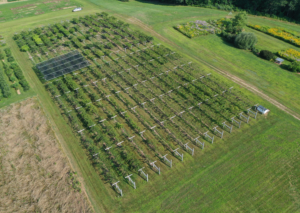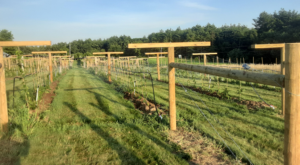Guide and Program Updates
January 2021
• We have been working with Hartmann’s Plant Company and are pleased to announce that they are the first nursery to offer genetically certified kiwiberry vines for retail and wholesale supply. Other nurseries wishing to be certified as having true-to-type kiwiberry cultivars should contact Iago Hale [iago.hale at unh.edu] to discuss the possibilities.
• We have made substantial updates to the Available Commercial Cultivars; Planting Material; Insect pests, diseases, and other production concerns; and Post-Harvest sections of this guide. The changes reflect our ever-improving understanding of which kiwiberry cultivars are commercially viable and recommended for our region. Other more minor updates have been made throughout the guide, inlcuding the list of recommended Grower Resources (Appendix 1).
• Last season, we completed the second expansion of our research and breeding vineyard, bringing the total footprint of our program to just over 2 acres at the NHAES (Images 1 and 2). This vineyard follows the same layout and irrigation design as described in Vineyard Establishment. We used pressure treated lumber for the posts and T-bars in this expansion, a departure from the locust posts and rough-sawn lumber used in our other vineyard sections. The expansion facilitated the establishment of nearly 2,000 new vines last season, a mixture of populations for breeding and genetic research.
Image 1 The NHAES vineyard in July 2019, consisting of the core A. arguta and A. kolomikta collections planted in 2013 (upper half), as well as the 0.75 acre vineyard expansion completed in 2016 (lower half).
Image 2 On the ground among breeding populations in our second vineyard expansion, completed in 2020.



